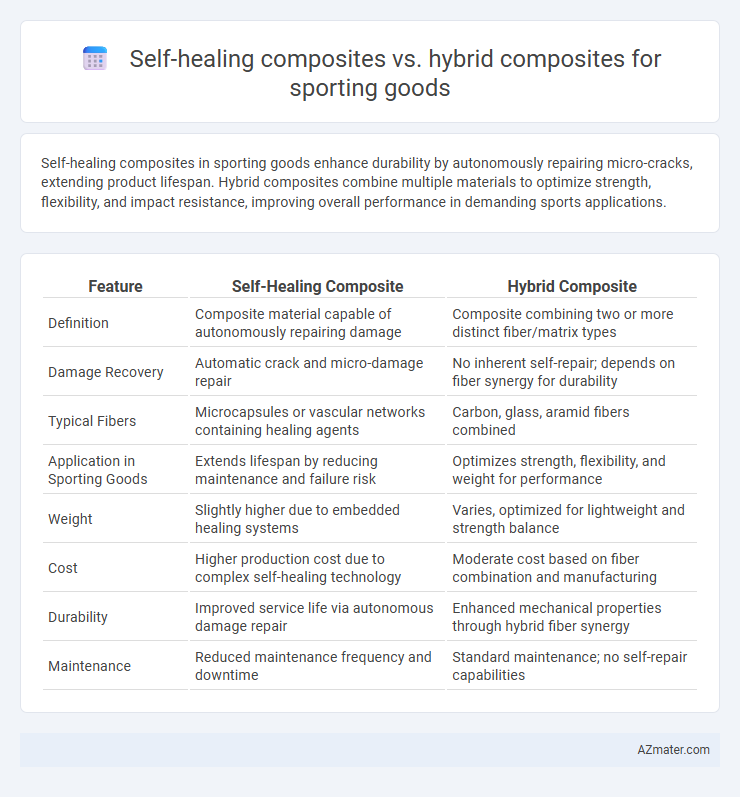Self-healing composites in sporting goods enhance durability by autonomously repairing micro-cracks, extending product lifespan. Hybrid composites combine multiple materials to optimize strength, flexibility, and impact resistance, improving overall performance in demanding sports applications.
Table of Comparison
| Feature | Self-Healing Composite | Hybrid Composite |
|---|---|---|
| Definition | Composite material capable of autonomously repairing damage | Composite combining two or more distinct fiber/matrix types |
| Damage Recovery | Automatic crack and micro-damage repair | No inherent self-repair; depends on fiber synergy for durability |
| Typical Fibers | Microcapsules or vascular networks containing healing agents | Carbon, glass, aramid fibers combined |
| Application in Sporting Goods | Extends lifespan by reducing maintenance and failure risk | Optimizes strength, flexibility, and weight for performance |
| Weight | Slightly higher due to embedded healing systems | Varies, optimized for lightweight and strength balance |
| Cost | Higher production cost due to complex self-healing technology | Moderate cost based on fiber combination and manufacturing |
| Durability | Improved service life via autonomous damage repair | Enhanced mechanical properties through hybrid fiber synergy |
| Maintenance | Reduced maintenance frequency and downtime | Standard maintenance; no self-repair capabilities |
Introduction to Advanced Composites in Sporting Goods
Self-healing composites in sporting goods utilize embedded microcapsules or vascular networks that autonomously repair damage, enhancing durability and extending product lifespan. Hybrid composites combine multiple fiber types, such as carbon and glass, to optimize strength, flexibility, and weight, catering to diverse performance requirements. Both advanced composites significantly elevate the mechanical performance and reliability of sporting equipment like tennis rackets, bicycles, and protective gear.
Understanding Self-Healing Composite Materials
Self-healing composite materials in sporting goods incorporate embedded microcapsules or vascular networks that release healing agents upon damage, enabling automatic repair and extended product lifespan. These composites enhance durability and reduce maintenance compared to traditional hybrid composites, which combine two or more distinct fibers or matrices to optimize mechanical properties without autonomous repair capability. Understanding the mechanisms of self-healing composites is crucial for advancing lightweight, resilient sporting equipment designed to withstand frequent impacts and stresses.
What Are Hybrid Composites?
Hybrid composites in sporting goods combine two or more different fiber types, such as carbon and glass fibers, to enhance mechanical properties like strength, stiffness, and impact resistance. These composites offer tailored performance by leveraging the distinct advantages of each fiber, improving durability and lightweight characteristics essential for high-performance sports equipment. Self-healing composites differ by incorporating materials that can automatically repair damage, but hybrid composites prioritize structural optimization through fiber synergy.
Key Performance Differences: Self-Healing vs Hybrid Composites
Self-healing composites in sporting goods offer enhanced durability by autonomously repairing microcracks, significantly extending the product's lifespan compared to hybrid composites. Hybrid composites combine fibers like carbon and glass to optimize strength-to-weight ratio and impact resistance but lack intrinsic regenerative capabilities. The key performance difference lies in self-healing composites' ability to maintain structural integrity under repeated stress, whereas hybrid composites primarily maximize mechanical performance and stiffness without self-repair features.
Durability and Longevity Comparison
Self-healing composites in sporting goods offer enhanced durability by autonomously repairing micro-cracks and damage, significantly extending the material's lifespan under repeated stress. Hybrid composites combine different fiber materials to optimize strength and toughness, providing reliable longevity but lacking the intrinsic repair capabilities of self-healing systems. Compared to hybrid composites, self-healing composites reduce maintenance needs and improve overall durability, making them highly suitable for high-performance sports equipment subjected to frequent impact and wear.
Impact Resistance in Sports Applications
Self-healing composites in sporting goods offer enhanced impact resistance by autonomously repairing microcracks caused by collisions or heavy use, extending the lifespan of equipment such as helmets and protective gear. Hybrid composites combine materials like carbon fiber and Kevlar to create a synergistic effect that improves toughness and energy absorption during high-impact sports activities. The choice between self-healing and hybrid composites depends on the specific performance requirements, with self-healing materials excelling in durability and hybrid composites providing superior immediate impact resistance.
Weight and Flexibility Considerations
Self-healing composites in sporting goods offer enhanced durability by autonomously repairing microcracks, maintaining structural integrity without added weight, which is crucial for athletes seeking lightweight equipment. Hybrid composites combine different fiber materials, optimizing flexibility and strength, but may introduce additional weight due to the layered construction. Weight-sensitive applications benefit from self-healing technologies to preserve agility, while hybrid composites excel where tailored flexibility and impact resistance are prioritized.
Cost Analysis: Self-Healing vs Hybrid Composites
Self-healing composites in sporting goods typically incur higher initial manufacturing costs due to advanced repair mechanisms and specialized materials, while hybrid composites offer a more cost-effective solution by combining cheaper reinforcement fibers with traditional matrices. The long-term maintenance cost of self-healing composites is lower as they autonomously repair micro-damages, extending product lifespan and reducing the need for manual repairs or replacements. Hybrid composites balance performance and cost, providing moderate durability and repair needs, making them a preferred choice for budget-conscious sports equipment manufacturers.
Sustainability and Recyclability Factors
Self-healing composites in sporting goods enhance sustainability by extending product lifespan through autonomous damage repair, reducing material waste and frequent replacements. Hybrid composites combine different fibers and matrices to optimize mechanical performance but present challenges in recyclability due to mixed material streams and complex separation processes. Prioritizing self-healing composites supports eco-friendly manufacturing and end-of-life management, aligning with circular economy goals in the sports equipment industry.
Future Trends in Sporting Goods Composite Technology
Self-healing composites in sporting goods enhance durability by autonomously repairing micro-cracks, extending product lifespan and reducing maintenance costs. Hybrid composites combine multiple materials like carbon fiber and fiberglass to achieve superior strength-to-weight ratios, improving performance characteristics such as flexibility and impact resistance. Future trends emphasize integrating self-healing capabilities within hybrid composite structures to create next-generation sports equipment offering exceptional resilience and ultra-lightweight design for elite athletic performance.

Infographic: Self-healing composite vs Hybrid composite for Sporting goods
 azmater.com
azmater.com